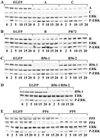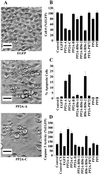Actions of PP2A on the MAP kinase pathway and apoptosis are mediated by distinct regulatory subunits - PubMed
- ️Tue Jan 01 2002
Actions of PP2A on the MAP kinase pathway and apoptosis are mediated by distinct regulatory subunits
Adam M Silverstein et al. Proc Natl Acad Sci U S A. 2002.
Abstract
Individual subunits of protein phosphatase 2A (PP2A), protein phosphatase 4, and protein phosphatase 5 were knocked out in Drosophila Schneider 2 cells by using RNA interference. Ablation of either the scaffold (A) or catalytic (C) subunits of PP2A caused the disappearance of all PP2A subunits. Treating cells with double-stranded RNA targeting all four of the Drosophila PP2A regulatory subunits caused the disappearance of both the A and C subunits. The loss of PP2A subunits was associated with decreased protein stability indicating that only the heterotrimeric forms of PP2A are stable in intact cells. Ablation of total PP2A by using double-stranded RNA against either the A or C subunit, or specific ablation of the R2/B regulatory subunit, enhanced insulin-induced ERK activation. These results indicated that the R2/B subunit targets PP2A to the mitogen-activated protein (MAP) kinase cascade in Schneider 2 cells, where it acts as a negative regulator. A severe loss of viability occurred in cells in which total PP2A or both isoforms of the Drosophila R5/B56 subunit had been ablated. The reduced viability of these cells correlated with the induction of markers of apoptosis including membrane blebbing and stimulation of caspase-3-like activity. These observations indicated that PP2A has a powerful antiapoptotic activity that is specifically mediated by the R5/B56 regulatory subunits. In contrast to PP2A, ablation of protein phosphatase 4 caused only a slight reduction in cell growth but had no effect on MAP kinase signaling or apoptosis. Depletion of protein phosphatase 5 had no effects on MAP kinase, cell growth, or apoptosis.
Figures

RNAi knockout of PP2A, PP4, and PP5 in Drosophila S2 cells. (A) Drosophila S2 cells were incubated in the presence of dsRNA corresponding to EGFP or the phosphatase subunits indicated at the top. After 72 h, cells were lysed in RIPA buffer containing 0.2 mM Na2VO4 and 10 mM NaF2, and lysates were clarified by centrifugation. Equal amounts of protein (30–60 μg) were separated on SDS-polyacrylamide gels, and detected by Western blotting with antibodies against the proteins indicated on the right. (B) Drosophila S2 cells were incubated in the absence or presence of dsRNA corresponding to EGFP or the phosphatase subunits indicated at the top. After 72 h, RT-PCR was performed as described under Materials and Methods, with primers against the phosphatase subunits indicated at the right. Individual reactions (5 μl of the final reaction mixture) were resolved on a 1% agarose gel and detected by staining with ethidium bromide. Results shown are representative of three to seven experiments.

Loss of the PP2A holoenzyme destabilizes individual PP2A subunits. Drosophila S2 cells were incubated in the presence of EGFP, A- or C-subunit dsRNA for 48 h (Right). The cells were then treated with 500 μM cycloheximide for the times indicated and lysed in RIPA buffer containing 0.2 mM Na2VO4 and 10 mM NaF2. Lysates were clarified by centrifugation, and equal amounts of proteins (50 μg) were resolved by SDS-polyacrylamide gel electrophoresis and detected by Western blotting with antibodies against the A, C, R2/B, or R5/B56–1 subunits as indicated at the right of each row. Results shown are representative of three experiments.

PP2A negatively regulates insulin-dependent ERK activation. Drosophila S2 cells were incubated in the presence of dsRNA targeted to EGFP or to the specific phosphatase subunits indicated across the tops of A–E. After 72 h, cells were treated with 10 μg/ml insulin for the minutes indicated at the bottoms of A–E and lysed in RIPA buffer containing 0.2 mM Na2VO4 and 10 mM NaF2. Lysates were clarified by centrifugation, and equal amounts of protein (50 μg) were resolved by SDS/PAGE. Proteins were transferred to nitrocellulose membranes and Western blotted with antibodies against the PP2A-A, -C, -R2/B, -R5/B56–1, PP4, or PP5 as indicated at the right of each row. MAP kinase activation was detected by blotting with antibodies specific for the phosphorylated forms of ERK-1 and -2 (P-ERK). The amount of MAP kinase in each sample was determined by blotting with an antibody that recognizes both the phosphorylated and nonphosphorylated forms of ERK-1 and ERK-2. Results shown are representative of three to five experiments for each dsRNA treatment.

Depleting the PP2A R2/B56 regulatory subunit reduces Drosophila S2 cell number and activates apoptosis. (A–C) Drosophila S2 cells were incubated in the absence (Control) or presence of dsRNA targeted to EGFP or to the specific phosphatase subunits indicated at the bottom of A–C. After 72 h, cells were photographed with phase-contrast optics. (Magnification ×32.) (A) Depleting the PP2A-A or -C subunit reduces cell number and increases membrane blebbing. Representative photographs are shown for cells treated with dsRNAs targeting EGFP or the PP2A A or C subunits. (Bar = 10 μm.) (B) Depleting the PP2A-A , -C subunit, or both R2/B56 regulatory subunits reduces Drosophila S2 cell number. dsRNA-treated cells from ×32 magnification fields were counted, and values represent the mean ± SE from four experiments treated with two different batches of dsRNA where at least three fields from each treatment were scored. (C) Depleting the PP2A-A, -C subunit, or both R2/B56 regulatory subunits induces membrane blebbing in Drosophila S2 cells. dsRNA-treated cells from magnification fields ×32 were scored for total cells and apoptotic (membrane blebbing) cells, and % apoptotic values represent the mean ± SE from three experiments treated with two different batches of dsRNA where at least three fields from each treatment were scored. (D) Depleting the PP2A-A, -C subunit, or both R2/B56 regulatory subunits stimulates caspase-3-like activity. Drosophila S2 cells were incubated in the absence or presence of 500 μM cycloheximide (CX) for 3 h, or dsRNA targeted to EGFP or to the specific phosphatase subunits indicated at the bottom for 3 days. Caspase assays were performed as described under Materials and Methods. Values represent the mean caspase-3 activity ± SE from four experiments. Caspase activity was normalized for protein concentration and expressed as a percent of EGFP dsRNA-treated cells.
Similar articles
-
Li X, Scuderi A, Letsou A, Virshup DM. Li X, et al. Mol Cell Biol. 2002 Jun;22(11):3674-84. doi: 10.1128/MCB.22.11.3674-3684.2002. Mol Cell Biol. 2002. PMID: 11997504 Free PMC article.
-
A functional genomics analysis of the B56 isoforms of Drosophila protein phosphatase 2A.
Liu W, Silverstein AM, Shu H, Martinez B, Mumby MC. Liu W, et al. Mol Cell Proteomics. 2007 Feb;6(2):319-32. doi: 10.1074/mcp.M600272-MCP200. Epub 2006 Nov 22. Mol Cell Proteomics. 2007. PMID: 17121811
-
Letourneux C, Rocher G, Porteu F. Letourneux C, et al. EMBO J. 2006 Feb 22;25(4):727-38. doi: 10.1038/sj.emboj.7600980. Epub 2006 Feb 2. EMBO J. 2006. PMID: 16456541 Free PMC article.
-
Protein phosphatase 2A: who shall regulate the regulator?
Goldberg Y. Goldberg Y. Biochem Pharmacol. 1999 Feb 15;57(4):321-8. doi: 10.1016/s0006-2952(98)00245-7. Biochem Pharmacol. 1999. PMID: 9933020 Review.
-
Phosphatases in apoptosis: to be or not to be, PP2A is in the heart of the question.
Van Hoof C, Goris J. Van Hoof C, et al. Biochim Biophys Acta. 2003 May 12;1640(2-3):97-104. doi: 10.1016/s0167-4889(03)00029-6. Biochim Biophys Acta. 2003. PMID: 12729918 Review.
Cited by
-
Deregulation of the protein phosphatase 2A, PP2A in cancer: complexity and therapeutic options.
Grech G, Baldacchino S, Saliba C, Grixti MP, Gauci R, Petroni V, Fenech AG, Scerri C. Grech G, et al. Tumour Biol. 2016 Sep;37(9):11691-11700. doi: 10.1007/s13277-016-5145-4. Epub 2016 Jul 21. Tumour Biol. 2016. PMID: 27444275 Review.
-
The tumor suppressor PP2A Abeta regulates the RalA GTPase.
Sablina AA, Chen W, Arroyo JD, Corral L, Hector M, Bulmer SE, DeCaprio JA, Hahn WC. Sablina AA, et al. Cell. 2007 Jun 1;129(5):969-82. doi: 10.1016/j.cell.2007.03.047. Cell. 2007. PMID: 17540176 Free PMC article.
-
Kins S, Kurosinski P, Nitsch RM, Götz J. Kins S, et al. Am J Pathol. 2003 Sep;163(3):833-43. doi: 10.1016/S0002-9440(10)63444-X. Am J Pathol. 2003. PMID: 12937125 Free PMC article.
-
Mauna JC, Miyamae T, Pulli B, Thiels E. Mauna JC, et al. Hippocampus. 2011 Oct;21(10):1093-104. doi: 10.1002/hipo.20823. Epub 2010 Sep 7. Hippocampus. 2011. PMID: 20824729 Free PMC article.
-
Battaglia-Hsu SF, Akchiche N, Noel N, Alberto JM, Jeannesson E, Orozco-Barrios CE, Martinez-Fong D, Daval JL, Guéant JL. Battaglia-Hsu SF, et al. Proc Natl Acad Sci U S A. 2009 Dec 22;106(51):21930-5. doi: 10.1073/pnas.0811794106. Epub 2009 Dec 3. Proc Natl Acad Sci U S A. 2009. PMID: 19959661 Free PMC article.
References
-
- Virshup D M. Curr Opin Cell Biol. 2000;12:180–185. - PubMed
-
- Zhao Y, Boguslawski G, Zitomer R S, DePaoli-Roach A A. J Biol Chem. 1997;272:8256–8262. - PubMed
-
- Kamibayashi C, Estes R, Lickteig R L, Yang S-I, Craft C, Mumby M C. J Biol Chem. 1994;269:20139–20148. - PubMed
-
- Haccard O, Jessus C, Cayla X, Goris J, Merlevede W, Ozon R. Eur J Biochem. 1990;192:633–642. - PubMed
Publication types
MeSH terms
Substances
LinkOut - more resources
Full Text Sources
Other Literature Sources
Molecular Biology Databases
Research Materials
Miscellaneous